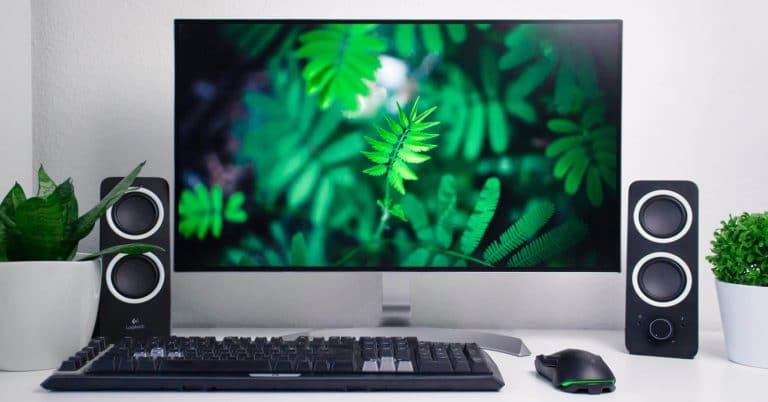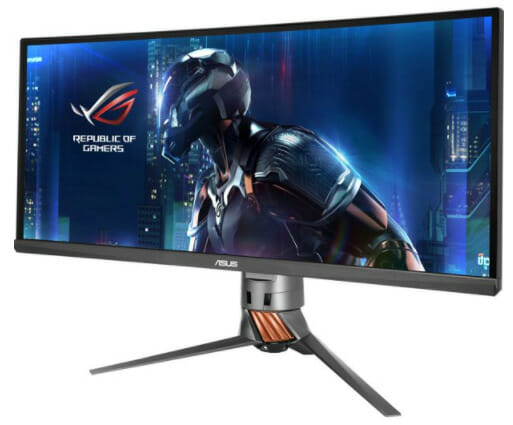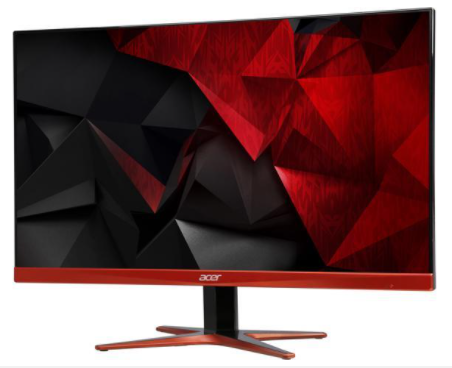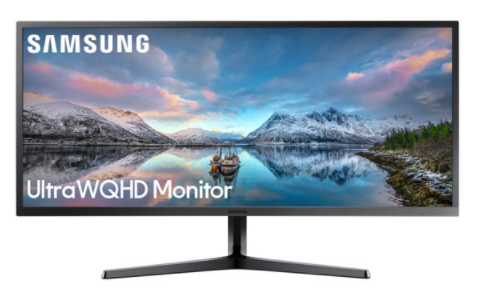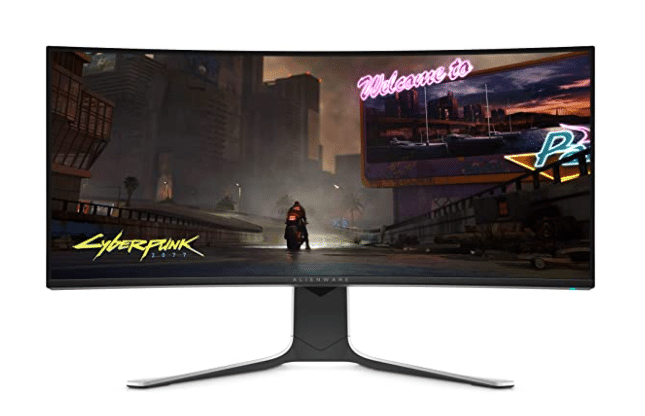9 Top Picks
4 Reviewers
30 Hours of Research
30 Options Considered
I remember the time I ditched my 1080p monitor to get a 1440p 144hz G Sync gaming monitor. This upgrade literally opened my eyes to a whole new realm of high-quality gaming. The higher pixel density lets you reach your full potential in FPS games where every detail matters, making it a must have for those looking for an immersive experience. After years of playing Counterstrike, BattleField, and even League of Legends I've tried dozens of monitors. Here are my what I consider to be the top nine of the best 1440p monitors in 2023!
3 Top PC Monitor
1. [Best 1440p Monitor Overall]
4.9/5
If money isn’t an issue, you should definitely take a look at the AW3420DW monitor from Alienware.
If Alienware doesn’t sound familiar, I’m sure you’d be delighted to know that it’s Dell’s gaming subsidiary.
2. [Best For The Money] ViewSonic VP2768 PRO 27" QHD Monitor
4.8/5
Do you edit videos and images for a living? If so, you should absolutely take a look at the ViewSonic VP2768 PRO. In addition, check out our video editing monitor lineup.
Its high color accuracy and moderate screen size will help you achieve better results without demolishing your budget.
3. [Best For The Response Time] Asus TUF Gaming VG27BQ 27” QHD Monitor
4.7/5
We’re back again with the best gaming monitors, but this time with Asus.
The VG27BQ is a 1440p hdr monitor that features a fascinating response time of 0.4 ms, making it an exceptional choice for FPS games.
Best 1440p Monitor Reviews
[Best 1440p Monitor Overall]
4.9/5
If money isn’t an issue, you should definitely take a look at the AW3420DW monitor from Alienware. If Alienware doesn’t sound familiar, I’m sure you’d be delighted to know that it’s Dell’s gaming subsidiary.
Image Quality
The Alienware AW3420DW is a 1440p ultrawide monitor that features a 34” IPS panel with a resolution of 3440x1440p. If you do the math, you’ll realize that it has a pixel density of 109 PPI, which makes for satisfyingly sharp image quality and smooth gameplay.
The official reports say that the backlight gives 350 nits with a contrast ratio of 1000:1 for dark scenes in your games. I know that you can find monitors generating much brighter images with sharper contrast, but this is the typical range for most IPS panels.
When I first tried this gaming monitor, the color inaccuracy was rated at 3.83 dE, which is simply hideous! Luckily, after proper calibration, that value dwindled to a satisfying 0.4 dE. That minimal inaccuracy was particularly noticeable with blue tones, making the monitor look a bit warmer than average.
Features:
- The outstanding response time unlocks your maximum potential in fast motion games
- The wide aspect ratio facilitates multi-tasking
- It renders 98% of the DCI-P3 color gamut, which gives amazing color accuracy
- The G Sync panel supports AMD cards for better versatility
- The VESA-compatible stand provides various setup options for more desk space
Alienware AW3420DW Monitor Specifications
Screen Size | 34 inches |
Display Panel | IPS |
Max. Resolution | 3440x1440p |
Response Time | 2ms |
Aspect Ratio | 21:9 |
Refresh Rate | 120Hz |
Adaptive Sync | Nvidia G Sync Compatible |
Performance
The thing I liked the most about this fantastic monitor is the outstanding response time. At 2 ms, you’re guaranteed to enjoy your beloved fast-paced FPS games without experiencing those infernal lags. It’s somewhat rare to find an IPS panel capable of providing that performance.
Because this ultrawide gaming monitor features G Sync technology, it’ll perform best with a compatible Nvidia graphics card. I’m not saying that it’ll be choppy with an AMD card, but you can’t expect the same flawless performance.
The only thing I wish was different is the variable refresh rate. Don’t get me wrong, though. 120 Hz is good for a monitor but you can find many 1440p 144hz IPS monitors at a tad higher price, making this monitor seem slightly less valuable.
Design and Connectivity
Alienware really outdid themselves while designing this monitor. The silver/black stand is equipped with an oval RGB light ring, which gives a mesmerizing futuristic vibe. Having the illuminated Alienware logo sitting at the top corner of the monitor compliments that vibe without looking too crowded.

On the right hand of the stand, you’ll find two ports: HDMI and DisplayPort 1.2. On the left side, there are three USB 3.0 ports, one upstream and two downstream. I sure wanted to see a USB-C port, but it’s not a major deal-breaker.
All in all, the Alienware AW3420DW is one of the 1440p best gaming monitors that perform equally well for general work purposes.
Pros
Cons
[Best For The Money]
4.8/5
Do you edit videos and images for a living? If so, you should absolutely take a look at the ViewSonic VP2768 PRO. Its high color accuracy and moderate screen size will help you achieve better results without demolishing your budget.
Image Quality
This monitor features a 27” IPS panel with a resolution of 2560x1440p. The backlight can give 350 nits with a 1000:1 native contrast ratio, which are the same values we saw in my first pick. Again, they’re not on the higher contrast ratio side, but they should be more than enough for professional editors.
Features:
- The 14-bit LUT system provides vibrant, lifelike images
- The low color inaccuracy boosts the performance of photographers and video editors
- The color uniformity function corrects any image flaws
- The Wide viewing angle facilitates use in a multi-monitor setup
- The DisplayPort output can daisy-chain up to four monitors
ViewSonic VP2768 PRO 27" QHD Monitor Specifications
Screen Size | 27 inches |
Display Panel | IPS |
Max. Resolution | 2560x1440p |
Response Time | 14ms |
Aspect Ratio | 16:9 |
Refresh Rate | 60Hz |
Adaptive Sync | N/A |
When I was testing this monitor, the first thing that grabbed my attention was the impressive color vibrancy, courtesy of the 14-bit LUT system.
The monitor successfully rendered 99% of the sRGB color gamut range, and it scored 1.7 dE in terms of color inaccuracy. These stats will indeed generate lifelike images, which is an indispensable attribute for photographers.
To top it all off, ViewSonic equips this monitor with a color uniformity function that’s supposed to correct any flaws when photo editing. However, this function may inadvertently bring the contrast down to 450:1, affecting the performance inside well-lit rooms. The good news is, you can easily turn off this feature and use the screen with the maximum specs.
Performance
If you’re planning to blow off some steam after work with a game of Battlefield V, this monitor isn’t for you. With a response time of 14 ms, enemies will score dozens of headshots against you with absolute ease. Even if you’re an exceptional player, the rather choppy input lag and lower refresh rate (60 Hz) are bound to cap your skills.
On the contrary, non-competitive games will work pretty well. The amazing visuals of The Last of Us 2 looked stunning on this monitor. To be honest, I wasn’t expecting that performance, especially because of the affordable price tag.
I was also happy about the viewing angle. Even if you gaze upon this monitor from far sides, you won’t notice any color shifting or local dimming feature.

Pros
Cons
[Best For The Response Time]
4.7/5
We’re back again with the best gaming monitors, but this time with Asus. The VG27BQ is a 1440p HDR monitor (high dynamic range) that features a fascinating response time of 0.4 ms, making it an exceptional choice for FPS games.
Image Quality
This monitor works via a 27” TN panel with a resolution of 2560x1440p. This equates to 109 PPI of pixel density, which is the same value offered by the Alienware AW3420DW. I was super satisfied with how this density generated sharp images in all the games I tested.
Features:
- The high pixel density displays sharp images
- The GameVisual modes tailor the monitor to match your real-time use
- The HDR10 compatibility improves the contrast of the TN panel
- The ELMB Sync works with the 0.2ms response time to provide the smoothest performance possible
- G Sync compatibility increases the monitor’s versatility
Asus TUF Gaming VG27BQ 27” QHD Monitor Specifications
Screen Size | 27 inches |
Display Panel | TN |
Max. Resolution | 2560x1440p |
Response Time | 0.4 ms |
Aspect Ratio | 16:9 |
Refresh Rate | Base: 155 Hz, Overclock: 165 Hz |
Adaptive Sync | ELMB Sync with G Sync Compatible |
Just like the previous monitors, the backlight gives 350 nits with a static contrast of 1000:1. How can a TN panel provide that performance, you might ask? Well, it’s all thanks to the HDR10 compatibility. With that feature enabled, the monitor can cover a surprising 99% of the sRGB color gamut range, which most gaming monitors should.
What amazed me the most in this monitor was the GameVisual feature. With this technology, you can keep playing games with seven preset display modes, each of which is tailored toward specific content.
For example, the “FPS” mode soars up the contrast to enhance visibility in dark game scenes. The “Cinema” mode, on the contrary, increases the saturation for you to enjoy lifelike movies and series.
Performance
Like I said earlier, the most distinctive thing about this monitor is the 0.4ms response time. And you know what's even better? The ELMB sync.
Short for “extreme low motion blur”, the ELMB is an exclusive technology developed by Asus to dial down smearing and ghosting. This technology is also Nvidia’s G sync compatible, eliminating the possibility of tearing and choppy frame rates.

Pros
Cons
Are you searching for a curved 144hz 1440p monitor? The MSI Optix MAG27CQ should be your best bet. Its low response time and eminently rich and gorgeous colors will guarantee the most immersive PC gaming experience.
Image Quality
This monitor is the first VA-paneled option on my list. It has a resolution of 2560x1440p with a 1800R curvature. Although I prefer the wider curvature of 21:9 monitors, I’d rather have a small curvature than a 100% flat screen.
MSI Optix MAG27CQ 27” WQHD Curved Monitor Specifications
Screen Size | 27 inches |
Display Panel | VA Panel |
Max. Resolution | 2560x1440p |
Response Time | 1ms |
Aspect Ratio | 16:9 |
Refresh Rate | 144 Hz |
Adaptive Sync | AMD FreeSync |
The monitor’s backlight generates 250 nits, which is so far the lowest value on my list. However, you probably won’t notice any issues unless you use the monitor in a sunny room. The good news is, when the night falls, you’ll enjoy the prominent 3000:1 contrast, which is especially perfect for die-hard FPS fans.
When the time comes for a movie night, the jaw-dropping color accuracy will double the fun! You’d be happy to know that this ultrawide gaming monitor covers 85% of the NTSC color gamut range. It might look too modest, but it actually equates to 110% of the sRGB range!
Performance
Because this curved monitor features a 144Hz refresh rate and 1ms response time, it’ll work perfectly with fast-paced games.
I was particularly interested in how good is this monitor for racing games. TT Isle of Man 2 and F1 2021 were simply amazing. I was able to finish the most challenging races with the sharpest turns, all thanks to the tiny input lag.
I was also happy about the generous 178° viewing angle. That will give you broad leeway to adjust your setup without having to trade off color accuracy.

Pros
Cons
4.6/5
The Samsung SD850 is one of the main competitors of ViewSonic VP2768. It’s not ideal for gaming, but it goes above and beyond expectations when it comes to professional work.
Image Quality
This monitor is based on a 32” AMVA panel — one of the latest technologies on the market. This panel generates a maximum brightness of 300 nits, which slightly excels over the regular VA panels. The contrast (3000:1) and viewing angle (178°) haven’t changed, though.
Features:
- The moderately high contrast improves the image quality, especially with visually-rich movies
- The wide viewing angle unlocks broad multi-monitor setups and more screen space
- The various connections boost versatility
- The saturated and vivid colors facilitate professional video and photo editing
- You can display two sources at once for better multitasking
Samsung SD850 32" WQHD Monitor Specifications
Screen Size | 32 inches |
Display Panel | AMVA |
Max. Resolution | 2560x1440p |
Response Time | 5ms |
Aspect Ratio | 16:9 |
Refresh Rate | 60 Hz |
Adaptive Sync | N/A |
While I was testing this monitor, I wasn’t entirely satisfied with the image clarity. Pairing a 32” monitor with 2560x1440p resolution caps the pixel density at a depressing 91 PPI. Then again, this quality is pretty acceptable at this price point.
By default, the colors seemed a bit off. But after proper calibration, the monitor managed to render 100% of the sRGB color gamut.
Performance
With a maximum of 60 Hz, this monitor lies well outside the gaming category. That lower refresh rate raises the input lag to about 35 ms, impairing the monitor’s ability to handle fast-paced games. Mediocre games, however, rendered quite well with minimal motion blur.
As you might’ve expected, this monitor isn't sync compatible. But to be fair, it’s pretty much useless here. Most graphics cards don’t drop below 60 frames per second at 1440p, after all.
After excluding games, I had to head off to the brawny editing programs. Adobe Premiere and CyberLink PowerDirector ran flawlessly throughout my testing. The monitor’s vibrant colors helped me point out diminutive editing mistakes that I usually overlook on TN panel monitors.

Design and Connectivity
Samsung perfectly knows what goes into the making of professional office monitors. When viewed from the front, you’ll see nothing but a sleek brushed black finish. The rear surface is adorned with a textured grey finish, making for a fascinating premium vibe. The ergonomic stand can tilt, swivel, pivot, and change height adjustment.
Despite the screen’s affordable price, it’s equipped with plenty of useful ports. You’ll have an HDMI 1.4, Display port 1.2, DVI-D dual link, four down USB 2.0, and one up USB 3.0.
Pros
Cons
If you liked the Asus TUF VG27BQ, I’m sure you love its ultrawide curved counterpart: ASUS ROG Swift PG348Q.
Image Quality
The PG348Q features a 34” AH-IPS panel with a resolution of 3440x1440p, which translates to a 109PPI pixel density. The 3,800R curvature made me feel like I’m in the center of the action, unlocking my full potential in FPS games.
When compared to the VG27BQ, this monitor felt a bit dimmer since it can only offer 300 nits of maximum brightness with a contrast of 1000:1. However, this is definitely high enough for efficient performance in well-lit rooms.
Features:
- The 3,800R curvature with the 32” display allows for the most immersive gaming performance possible
- The 300nit brightness generates clear images in sunny rooms
- The 178° viewing angle ensures high quality in plenty of setups
- With the 10-bit compatibility, you’ll enjoy up to 1.07 billion distinct hues
- You can enable a fixed crosshair to fine-tune your aiming in FPS games
ASUS ROG Swift PG348Q 34" Ultra-Wide QHD Monitor Specifications
Screen Size | 34 inches |
Display Panel | AH-IPS |
Max. Resolution | 3440x1440p |
Response Time | 5ms |
Aspect Ratio | 21:9 |
Refresh Rate | 100 Hz |
Adaptive Sync | Nvidia G Sync Compatible |
The colors felt distinctly vibrant and lifelike, courtesy of the 10-bit color compatibility and the 100% sRGB coverage.
Performance
Because of the IPS technology, the PG348Q is capped at a 100Hz refresh rate and a 5ms response time. I was able to enjoy different FPS games with no major issue, but I wasn’t 100% happy about the minimal motion blur with the slower response times, especially with fast moving objects in darker scenes.
On the positive side, the G Sync compatible panel eliminated the screen tearing that we usually experience with large, ultrawide monitors.

Pros
Cons
If you like Acer’s state-of-the-art designs, consider the Acer Predator XB271HU. It’s a must-have for gamers who spend hours playing open-world games with immaculate graphics.
Image Quality
The XB271HU is based on a 27” IPS panel with a resolution of 2560x1440p, meaning that you’ll get a 109PPI pixel density. The backlight offers 350 nits of peak brightness with a 1000:1 contrast ratio, making it similar to my previous picks.
Features:
- The 165Hz refresh rate can render the most challenging games with a smooth quality
- The wide gamut coverage enhances the versatility for gaming performance and professional uses
- Thanks to the Nvidia GSync panel, you can forget about the screen tearing for good
- The high brightness will boost the quality regardless of the surrounding environment
- The high pixel density ensures top-notch sharpness
Acer Predator XB271HU bmiprz 27" WQHD Monitor Specifications
Screen Size | 27 inches |
Display Panel | IPS |
Max. Resolution | 2560x1440p |
Response Time | 4ms |
Aspect Ratio | 16:9 |
Refresh Rate | 165 Hz |
Adaptive Sync | ULMB and Nvidia G Sync Compatible |
Unfortunately, this monitor doesn’t come with factory calibration. But after playing around with the settings, it successfully rendered 100% of the sRGB color gamut range. This is partly because of the 10-bit dithered support, but the revamped IPS panel is the main feature you should be thankful for.
Performance
Although the 4ms response time isn’t the best on the market, the monitor manages to perform flawlessly because of the generous 165Hz variable refresh rate, which easily excels over the previous 144hz gaming monitors.
When connected to a compatible GeForce GTX card, the G Sync panel will dampen any sudden drops in frame rates to prevent that ugly screen tearing. If you have an AMD card, you can substitute with the ULMB (Ultra Low Motion Blur) technology to prevent image ghosting.

Since this great monitor is primarily intended for gamers, it’s equipped with a sharply outlined two-legged stand that has two bright red inserts. And of course, this stand can tilt, pivot, swivel, and change height to ensure optimal ergonomics.
You can run this monitor via an HDMI 1.4 port or a DisplayPort 1.2. You’ll also find five USB 3.0 ports (4 down & 1 up) to connect your smartphone, camera, and so forth.
Pros
Cons
If you want a 1440p 144hz gaming monitor that can work with AMD and Nvidia compatible graphics cards, take a look at the Acer XG270HU.
Image Quality and Performance
The Acer XG270HU is based on a 27” TN panel with a maximum resolution of 2560x1440p. The image was clear and sharp enough, but the colors didn’t feel as satisfying — this is mainly because it only supports 8-bit color depth, but it’s also related to the TN panel’s limited nature.
Features:
- It can run with old PCs by using the DVI port
- The powerful brightness (350 nits) will provide enough clarity in well-lit rooms
- Forget about motion blur and ghosting with the high refresh rates and short response time
- FreeSync display with G Sync compatibility
- The thin design will fit over small tables
Acer XG270HU omidpx 27” WQHD Monitor Specifications
Screen Size | 27 inches |
Display Panel | TN |
Max. Resolution | 2560x1440p |
Response Time | 1ms |
Aspect Ratio | 16:9 |
Refresh Rate | 144 Hz |
Adaptive Sync | AMD Free-Sync |
The thing that annoyed me the most about this monitor was the narrow viewing angle. Unless you’re sitting within 160° from the screen’s center, you’ll perceive inaccurate colors and inverted contrast.
However, when you sit in the monitor’s sweet spot, you’ll love its amazingly fluid performance. It can run with a 144Hz refresh rate with an amazing 1ms response time.
The FreeSync panel runs best with almost all AMD cards. Nvidia GTX 10 and newer cards will also run it with equally excellent performance, making it one of the best 1440p monitors for mixed setups.

Pros
Cons
The last monitor on my list is a 1440p ultrawide curved model from Samsung. Let’s see what the C34H890WJN has to offer. Maybe also get an ultra wide monitor from our lineup.
Image Quality and Performance
The Samsung C34H890WJN sports a 34” SVA panel that has a 3440x1440p resolution. I was a bit skeptical about the image sharpness at first, but I was delighted to know that it adds up to 109 PPI and also has good viewing angles.
Features:
- The various connections will work with dozens of setups
- The Picture-by-Picture feature will increase your multitasking efficiency
- The 1800R curvature makes for an immersive and responsive gaming experience
- The moderate variable refresh rates will work well for most games
- The high pixel density keeps the sharpness at optimal levels
Samsung C34H890WJN 34” UltraWide QHD Specifications
Screen Size | 34 inches |
Display Panel | SVA |
Max. Resolution | 3440x1440p |
Response Time | 4ms |
Aspect Ratio | 21:9 |
Refresh Rate | 100 Hz |
Adaptive Sync | AMD Free-Sync |
Although this monitor has a WLED backlight, it can only give 300 nits of brightness with a 3000:1 contrast ratio — this is by no means poor, but I was expecting a much higher contrast ratio.
Performance-wise, this monitor will be ideal for people who want a balance between working and gaming. The 100Hz refresh rate and 4ms response time aren’t superb, but they’ll be good enough for most games on moderate-to-high graphic settings.

Pros
Cons
Features to Look for in a 1440p Monitor
If this is your first time buying a monitor, the number of the specs you have to understand might seem too intimidating. Don’t fret, though. Here’s everything you need to know to get a monitor that truly fits your needs.
Resolution
The monitor’s resolution describes the number of pixels it has, both horizontally and vertically. Surely, more pixels will display better images with sharper outlines.
Since you’re searching for 1440p monitors, you already picked the number of vertical pixels. As for the horizontal pixels, you have two options: 2560p and 3440p.
Monitors with a resolution of 2560x1440p are known as WQHD monitors. These models have an aspect ratio of 16:9, which should be ideal for general work and gaming purposes.
On the other hand, full-time gamers should invest in an ultra-wide QHD monitor. With a higher resolution of 3440x1440p, you’ll have an edge over your opponents, especially in first-person shooters. If money isn’t an issue, you should also consider upgrading to a 4k gaming monitor to enjoy the best quality possible, but if you don't want to drop that cash don't fret - 1440 monitors are worth it.
Refresh Rate
Measured in hertz (Hz), the refresh rate states how many times your monitor updates its pixels per second. Getting a monitor with a high refresh rate means you will get a smooth performance with no choppiness or motion blur for fast moving objects in games.
Regular users can suffice with 60 Hz. Gamers, however, need at least 75 Hz to run games with moderate graphics. Extensive open-world games will require 144 or 200 Hz to run with the best graphics settings.
But before wasting money on a high-end monitor with a generous refresh rate, you must make sure that your graphics card is powerful enough to render as many frames.
Screen Size
Choosing screen size depends mainly on your personal preference. A 27” monitor should be ideal for most people because it gives enough viewable area without overwhelming the overall setup. It’ll also work perfectly if you’re planning a multi-monitor setup.
Gamers, graphic designers, and video editors will highly benefit from bigger screens. You can find several 34” 1440p 144hz 1ms monitors, which are the perfect specs for a flawless performance.
If you want a bigger size, a 1440p monitor may look too blurry. Alternatively, you should opt for a 4k 144hz gaming monitor or, preferably, a 4k monitor 40 inch in size. Acer Predator XB273K is one of the best 4k monitors currently on the market. It will give you immersive and responsive gaming experience.
When planning your setup, bear in mind that the screen size isn’t measured horizontally or vertically; it’s measured diagonally from one corner to another.
Panel Type
The panel type describes the technical component that generates the image inside your monitor.
Nowadays, you can find three panel technologies: twisted nematic (TN), in-plane switching (IPS panel), and vertical alignment (VA panel). Don’t worry, though. I won’t dive into the complex technicalities behind each type. I’ll only highlight what makes each panel stand out.
TN panels are the most ubiquitous on the market, mainly because of their economical price. Although these panels are quite inferior in terms of image quality and viewing angle, they have an impeccable response time.
IPS panels are quite the opposite. They’re expensive, but they generate amazing images with accurate colors, great viewing angles and screen space. Their only downside is the limited response time. Most 1440p IPS monitors need 5–10 ms to update their pixels, which might be a deal-breaker for avid gamers.
VA panels lie somewhere in the middle. They display much better and smoother images than TN panels, with a response faster than a IPS monitor. However, they’re not that common on the market.
Shape
Consider a curved display for a better viewing experience and eye care monitors if you want a more immersive gaming or multitasking experience.
Additionally, a curved display takes up less room on your desk. However, curved displays can reflect more glare when placed close to a window, so positioning is essential and you might encounter restrictions depending on your area.
They are typically a little more expensive than conventional flats.
Response Time
The response time describes the time your monitor needs to update each pixel from black to white, or from one shade of grey to another.
Gamers should pick a monitor with a response time of 5 ms or less, so as to prevent blurring or ghosting.
If you intend to use the monitor only for work, you can go all the way up to 15 ms without having any quality issues.
Input Lag
As the name implies, input lag describes the time your monitor needs to render whichever commands you input through the mouse or keyboard.
Do you need to worry about it? Well, not really. If you get a monitor with higher refresh rates and short response time, you can be almost certain that you’ll get a short input lag. That’s why many manufacturers don’t list it in the official specs.
If you still wish to know the input lag of a specific monitor, you’ll have to check its customer reviews.
Connections
Naturally, you should only buy monitors with ports that match your PC. Otherwise, you’ll have to use adaptors, which may detract from the monitor’s quality.
Here’s a quick rundown of the most famous ports:
DisplayPort: Gives the best image quality with the shortest input lag. It’s a must-have if you’ll use the monitor for gaming.
HDMI: This is the most common connection on the market. It might not be enough for gaming, but it’s surely sufficient for general use.
USB-C: This connection is the only one that can transfer video, data, and power. It makes for a much versatile monitor that can fit into various setups.
DVI: It was the official connection before HDMI came out. It’ll be ideal if you have an old PC, but it only transfers 1080p video signals at 144Hz.
VGA: A legacy connection that’s becoming less and less common. Just like DVI, it only carries video signals at low quality.
Adaptive Sync
If you get a monitor with adaptive sync, it’ll automatically adjust its refresh rate whenever your graphics card changes the rendered frame rate. This is extremely important for gamers because it prevents screen tearing, stuttering, and judder.
You can find two adaptive sync technologies on the market: FreeSync (from AMD), and G Sync (from Nvidia). Although both work equally well, FreeSync monitors can run with almost any graphics card, which is not always true for a G Sync gaming monitor.
If you’re getting a monitor for work, you can save considerable money by ditching the adaptive sync feature altogether.
Adjustability
The ideal monitor stand will be able to pivot, swivel, tilt, and rise and fall. If you're willing to shove books or anything similar underneath, you can get by with a less expensive, less adjustable support, but it's not nearly as convenient or solid as a real stand.
For the benefit of your posture and general comfort, we usually advise spending more money on a model with an adjustable stand. This is especially true if you intend to work or play for extended periods of time each day.
FAQs:
1. What is the best monitor 1440p?
Here are the Top 3 1440p Monitor that we can recommend.
1. Alienware AW3420DW 34-inch Curved Ultrawide QHD Monitor - If money isn’t an issue, you should definitely take a look at the AW3420DW monitor from Alienware.
If Alienware doesn’t sound familiar, I’m sure you’d be delighted to know that it’s Dell’s gaming subsidiary. With this width you'll have an amazing gaming experience and your whole peripheral vision will be filled.
2. ViewSonic VP2768 PRO 27-inch QHD Monitor - Do you edit videos and images for a living? If so, you should absolutely take a look at the ViewSonic VP2768 PRO. In addition, check out our video and photo editing monitor lineup. For those that work long hours, we recommend a monitor which decreases eye strain.
Its high color accuracy, as well as color vibrance, and moderate screen size will help you achieve better results without demolishing your budget.
3. Asus TUF Gaming VG27BQ 27-inch QHD Monitor - We’re back again with the best gaming monitors, but this time with Asus.
The VG27BQ is a 1440p HDR (high dynamic range) monitor that features a fascinating response time of 0.4 ms, making it an exceptional choice for FPS games.
2. Should I get 1440p or 1080p?
1080p is a more common resolution, so it might be easier to find monitors and other devices that support it. 1440p is higher resolution, so it might be a better choice if you have the hardware to support it and you're looking for the best possible image quality.
3. Should I buy a 1440p monitor?
1440p monitors offer more detail and clarity than 1080p monitors, so if you have the budget for it and want the best possible picture, then a 1440p monitor is a good investment. Keep in mind that not all software and games are optimized for 1440p yet, so you may need to adjust some settings to get the most out of your new monitor.
4. Is 144Hz good for 1440p?
Yes, 144Hz provides superior performance for less demanding eSports titles, while 1440p provides superior visuals for more graphically intensive games. The good news is that you can now purchase a gaming monitor that supports both 1440p and 144Hz resolutions at an affordable price.
5. Is 1440p Good for 27-inch monitor?
Yes, 1440p is good for 27 inch monitor. For instance, the 25601440 resolution on a 27-inch monitor enables you to open two browsers side by side and comfortably view content from both without overlapping. This makes 1440p monitors ideal for multitasking and professional use, even more so if you can afford two for a dual setup.
6. What size should I buy?
Though 24in is equally suitable for working or light gaming, it is generally agreed that 27in is the sweet spot for 1440p monitors. Nearly all WQHD gaming displays have a diagonal size of 27 inches. It just depends on your preferences and the space you have.
7. How much should I spend?
Gaming displays typically cost between $300 and $500, whereas a good 1440p workplace monitor should cost you between $200 and$300. If you're set on getting the best money can buy, you can pay up to $900.

